I'll start off by waxing poetic about ramen for a bit. I don't know if it's part of the nature of the Japanese culture or some other mysterious force that drove what should have been a dish that was nothing more than noodles in soup to evolve into one of the ultimate expressions of cooking. Over the years, every detail of ramen making has been improved over and over as ramen chefs strive for perfection. In a similar way, ramen lovers seek out different ramen-ya in hopes that they find one even better than the last. (One of the greatest movies about the love of food ever made, Tampopo, is about the pursuit of the perfect bowl of ramen.)
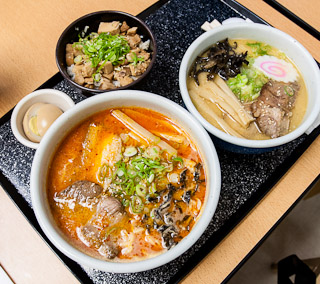 |
| Santouka Spicy Miso Ramen (and small tonkotsu ramen) |
Related Articles
Toppings for ramen are also widely varied including chashu (pork that has been rolled and braised at low temperature typically seasoned with honey and soy sauce), nori (roasted seaweed sheets), eggs (often poached [onsen tamago], marinated and soft boiled [ajitama], or hard boiled), kamaboko (fish cake), menma (marinated bamboo shoots), scallions, spinach, sweet corn, butter, bean sprouts, garlic, chili seasoning, mayu (sesame oil), beni shoga (pickled ginger), and more. A lot of people would consider chashu the most important topping as it is the traditional protein served with ramen with many ramen-ya offering options to add additional chashu to the ramen to make it an even heartier meal.
I could go on and on about ramen: the proper temperature the broth should be served at (it should be so hot that slurping, which incorporates cool air, is a necessity), the availability of kaedama (the option to purchase additional noodles after one has finished their noodles but still has broth remaining), the relatively recent popularity of miso ramen (and even more recent mala variant of spicy ramen)... but I should probably get on with the coverage of ramen in Austin.
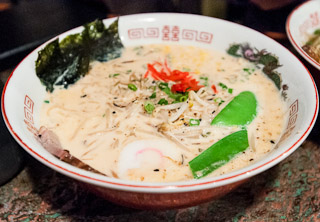 |
| Not good ramen - milk was added to color the broth |
Over the years, we satisfied our itch by seeking out ramen whenever we could while on vacation in New York City (Ippudo - just above average ramen but very hip vibe), Chicago (Noodles by Takashi Yagihashi - a straightforward ramen that satisfies but isn't phenomenal), and the San Francisco Bay Area (Orenchi - amazing chashu and tonkotsu broth, Santouka, Ramen Dojo), but it would be nice to have some ramen closer to home. In November 2011, we paid a visit to Komé which had opened up the previous month and was serving ramen at lunch. At the time, Komé was serving the best ramen in Austin but it still left a lot to be desired (and not quite good enough for us to return). Desperate, we drove to Houston and tried six different ramens all around town in hopes that a mega-metropolis known for their Asian cuisine would have a satisfying ramen. Of the traditional ramens, we only found one which we could recommend (the shoyu ramen served at Kata Robata). Then a miracle happened.
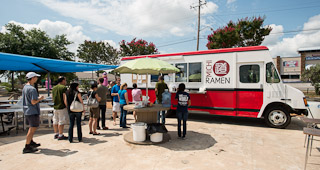 Michi Ramen opened their food truck for business serving fifty bowls of tokotsu ramen per service in North Austin around late April to early May 2012. We were in ramen bliss and even in the 100°F weather we would find time to make the trek up north to eat ramen.
Michi Ramen opened their food truck for business serving fifty bowls of tokotsu ramen per service in North Austin around late April to early May 2012. We were in ramen bliss and even in the 100°F weather we would find time to make the trek up north to eat ramen.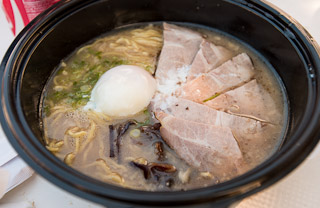 The tonkotsu ramen broth wasn't just good, it was great. One of the best examples of tokotsu broth we had tasted with richness that seemed like it was otherworldly.
The tonkotsu ramen broth wasn't just good, it was great. One of the best examples of tokotsu broth we had tasted with richness that seemed like it was otherworldly.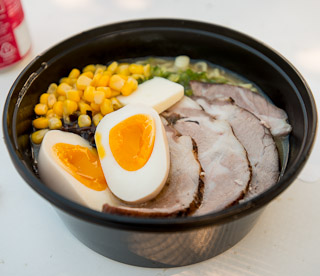 Unfortunately, eating a bowl of piping hot, super heavy noodle soup outdoors with only a thin mesh sheet hung over picnic tables and chairs to shield diners from the scorching Texas sun just wasn't the best situation over all. On June 17, 2012, Michi Ramen served their last bowl of ramen from their food truck and (having sold out every service and therefore certain there was ample demand for ramen) began their search for a brick and mortar restaurant. Once again, there was no ramen in Austin.
Unfortunately, eating a bowl of piping hot, super heavy noodle soup outdoors with only a thin mesh sheet hung over picnic tables and chairs to shield diners from the scorching Texas sun just wasn't the best situation over all. On June 17, 2012, Michi Ramen served their last bowl of ramen from their food truck and (having sold out every service and therefore certain there was ample demand for ramen) began their search for a brick and mortar restaurant. Once again, there was no ramen in Austin.A month passed and then a slow buzz started to build into a deafening roar which was impossible to ignore if you paid any attention to the food scene in Austin. The town's first ramen-ya was about to open and through excellent use of social media, everyone who bothered to seek them out could follow along on Facebook as Ramen Tatsu-ya painted their walls, designed their chairs and tables, experimented with side dishes, and teased the general public with "ramen shop coming soon" signs. It seemed that everyone who missed Michi Ramen's short run as a food truck was now gearing up to hit Ramen Tatsu-ya as soon as it opened. On August 24, 2012, Ramen Tatsu-ya (8557 Research Blvd # 126, Austin, TX) opened for business and was immediately overwhelmed. For months, the reports from friends who lived closer to the ramen-ya came flooding in: "excellent broth"; "good but a little thin compared to Michi"; "lines are too long - waited 45 minutes"; "go at 9pm on Thursday". I didn't get a chance to try Ramen Tatsu-ya for myself until after Christmas 2012 when we showed up after 9pm on a Thursday (the place was packed and the line was almost extending out the door).
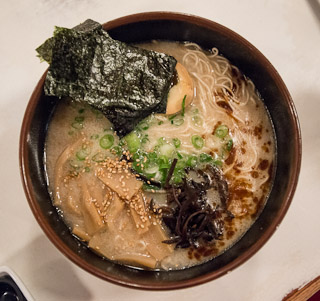 Over the next three weeks, we would return to Ramen Tatsu-ya three times tasting the different ramen variations. Their tonkotsu broth, although not as rich as Michi Ramen's broth, was full-flavored, nuanced, and delicious. Ramen Tatsu-ya uses the thinner noodles you would find in a traditional Hakata tonkotsu ramen but not so thin that they don't provide the pleasant chewiness that ramen noodles have. They also have the flavor of authentic alkali treated ramen noodles. The chashu Ramen Tatsu-ya serves is a roasted rolled pork belly finished with a quick sear to bring out more flavor of browned pork, honey, and soy sauce. The end result is an exquisite chashu as good as the best I've ever eaten. In fact, I would say the chashu is the most pleasurable thing to eat at Ramen Tatsu-ya. (They serve an excellent chashu bowl - for $5; $4 when purchased with ramen - that has an ample serving of their amazing chashu chopped up and served over steaming white rice and topped with refreshing chopped scallions which I crave more often than their ramen.)
Over the next three weeks, we would return to Ramen Tatsu-ya three times tasting the different ramen variations. Their tonkotsu broth, although not as rich as Michi Ramen's broth, was full-flavored, nuanced, and delicious. Ramen Tatsu-ya uses the thinner noodles you would find in a traditional Hakata tonkotsu ramen but not so thin that they don't provide the pleasant chewiness that ramen noodles have. They also have the flavor of authentic alkali treated ramen noodles. The chashu Ramen Tatsu-ya serves is a roasted rolled pork belly finished with a quick sear to bring out more flavor of browned pork, honey, and soy sauce. The end result is an exquisite chashu as good as the best I've ever eaten. In fact, I would say the chashu is the most pleasurable thing to eat at Ramen Tatsu-ya. (They serve an excellent chashu bowl - for $5; $4 when purchased with ramen - that has an ample serving of their amazing chashu chopped up and served over steaming white rice and topped with refreshing chopped scallions which I crave more often than their ramen.)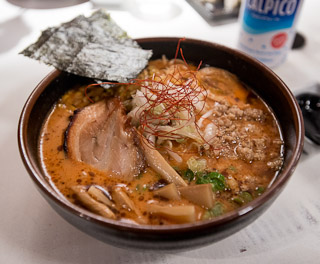 Ramen Tatsu-ya also allows you to easily customize your ramen with additions like the "spicy bomb" which makes your ramen spicy (but it doesn't just add heat, it also adds complex flavor some of which reminded us of the complexities of spicy Korean foods). If straight up chile pepper heat is what you're looking for, then "fire in a bowl bomb" adds the potent spiciness of habaneros to your broth. One of Tina's favorite toppings is the brussels sprouts (browned until nutty and slightly bitter) which adds yet another dimension to the noodle soup. We did find that the ramen overall was fairly salty on all three visits (and five bowls of ramen). By the third visit, we had learned the secret - order the ramen "less salty" and they provide you a small bowl of unsalted broth along with your ramen so you can adjust the saltiness of the broth without watering down the soup.
Ramen Tatsu-ya also allows you to easily customize your ramen with additions like the "spicy bomb" which makes your ramen spicy (but it doesn't just add heat, it also adds complex flavor some of which reminded us of the complexities of spicy Korean foods). If straight up chile pepper heat is what you're looking for, then "fire in a bowl bomb" adds the potent spiciness of habaneros to your broth. One of Tina's favorite toppings is the brussels sprouts (browned until nutty and slightly bitter) which adds yet another dimension to the noodle soup. We did find that the ramen overall was fairly salty on all three visits (and five bowls of ramen). By the third visit, we had learned the secret - order the ramen "less salty" and they provide you a small bowl of unsalted broth along with your ramen so you can adjust the saltiness of the broth without watering down the soup.Tsukemen (dipping style ramen), where thick ramen noodles are provided with a heavy broth (more concentrated than their regular ramen broth) to be eaten by dipping the noodles into the sauce and eating the noodles without soup, is also available.
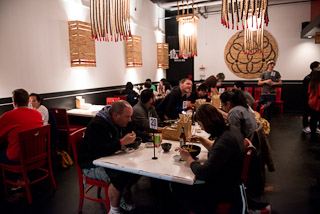 Overall, Ramen Tatsu-ya is pushing out some excellent ramen with wonderful toppings as their greatest achievement and an impressive broth.
Overall, Ramen Tatsu-ya is pushing out some excellent ramen with wonderful toppings as their greatest achievement and an impressive broth.Seating is fairly limited at Ramen Tatsu-ya, which might contribute to their long lines. Most of the tables are "community" tables where the people dining next to you could be strangers (allowing for a bonding opportunity with other Austinites who love ramen). There are a few tables against the wall where a couple could sit by themselves, but at really busy times, you might be asked if you would mind joining another couple willing to share their table. (You can, of course, refuse and wait for the next available table while the next group in line gets the opportunity to sit with strangers.) One last comment about their space is that either due to poor ventilation or the size of their kitchen and dining areas, the smell of charring chashu permeates the air. It's a wonderful smokey and savory smell that gets your saliva going as you stand in line and brings wonderful and pleasant thoughts to mind... but lingers on your clothes and hair until you wash them.
Seven months after serving their last bowl of ramen from the food truck, Michi Ramen (6519 North Lamar Boulevard, Austin, TX) opened the doors to their restaurant and started their soft opening. I ate there three times in their first 13 days and could not be happier that they had maintained the quality of their superb broth.
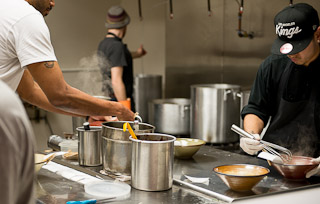 Since a food coma inducing super rich and hearty broth isn't for everyone, Michi Ramen offers three different levels of richness: stout (their richest full-bodied broth that is most similar to what was served at the food truck), regular (a rich broth), and light (a full flavored but less fatty broth). I plan on making a trip to eat both Michi Ramen and Ramen Tatsu-ya on the same night so I can properly compare the broths, but, making a judgement based on my taste memory, I would place Ramen Tatsu-ya's broth richness somewhere between Michi Ramen's regular and light.
Since a food coma inducing super rich and hearty broth isn't for everyone, Michi Ramen offers three different levels of richness: stout (their richest full-bodied broth that is most similar to what was served at the food truck), regular (a rich broth), and light (a full flavored but less fatty broth). I plan on making a trip to eat both Michi Ramen and Ramen Tatsu-ya on the same night so I can properly compare the broths, but, making a judgement based on my taste memory, I would place Ramen Tatsu-ya's broth richness somewhere between Michi Ramen's regular and light.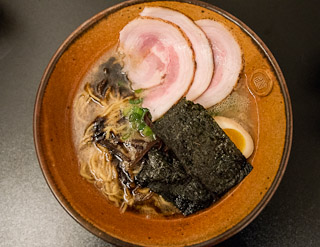 When they opened, Michi Ramen served a low temperature braised rolled pork belly (very traditional), but I found that that particular execution of that particular method of preparation for that particular cut in Michi Ramen's ultra-rich broth to not work as well as it should have. Michi Ramen has since switched to the pork shoulder chashu which they prepared during the summer and served at their food truck which I feel works decently well. It sounds like they're working on perfecting their pork belly recipe and might offer it as option on their menu in the future. (Pictured here in the Michi Ramen bowl is the pork belly from their very first night.) The noodles are made for Michi Ramen by a popular ramen noodle company in California who provides for many of the top notch ramen-ya on the West Coast and is flown in fresh. The texture, thickness, springiness, and flavor are just right (probably since I love West Coast ramen so much).
When they opened, Michi Ramen served a low temperature braised rolled pork belly (very traditional), but I found that that particular execution of that particular method of preparation for that particular cut in Michi Ramen's ultra-rich broth to not work as well as it should have. Michi Ramen has since switched to the pork shoulder chashu which they prepared during the summer and served at their food truck which I feel works decently well. It sounds like they're working on perfecting their pork belly recipe and might offer it as option on their menu in the future. (Pictured here in the Michi Ramen bowl is the pork belly from their very first night.) The noodles are made for Michi Ramen by a popular ramen noodle company in California who provides for many of the top notch ramen-ya on the West Coast and is flown in fresh. The texture, thickness, springiness, and flavor are just right (probably since I love West Coast ramen so much).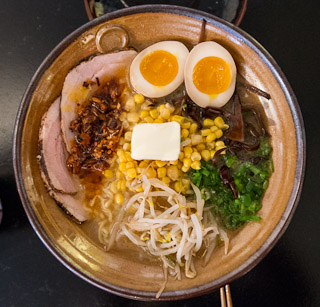 Sapporo Ramen (named after the city where miso ramen was first known to be served) has the tonkotsu broth with sweet miso paste, butter, corn, and bean sprouts. We really enjoyed the balance of the miso with the stout broth when we had it during the summer, but when we tried it with the light broth found it a little overpowering. It could have been that the kitchen was a tad heavy handed that night with our miso or that the miso just works better in the richer and fattier soup bases.
Sapporo Ramen (named after the city where miso ramen was first known to be served) has the tonkotsu broth with sweet miso paste, butter, corn, and bean sprouts. We really enjoyed the balance of the miso with the stout broth when we had it during the summer, but when we tried it with the light broth found it a little overpowering. It could have been that the kitchen was a tad heavy handed that night with our miso or that the miso just works better in the richer and fattier soup bases.Michi Ramen also has a vegetarian soup and allows you to fully customize your ramen by choosing the noodles and broth option and adding any toppings you might want.
Michi Ramen has a much larger space than Ramen Tatsu-ya and service (other than the very first night where I had to wait an acceptable 20 minutes for my food) is fast, helpful, and attentive. While Ramen Tatsu-ya is counter service (order food at the counter, pay up front, sit, they bring you the food, and leave whenever you are ready), Michi Ramen is a standard sit down restaurant where you get seated, order from a waiter from a menu, eat, and pay on a fancy tablet that gives you the option to email or print a receipt (if only all places provided the email option! OfficeMax also emails receipts and I'm growing to like the option). Another difference is that Michi Ramen's space is large enough that tables aren't crammed together and there's no chance of being bumped. However, decorations are sparse and it's clear they are running on a budget with all their focus being poured into their food. Ramen Tatsu-ya has Michi Ramen clearly beated when it comes to atmosphere (which is very carefully manufactured from the large wall dominating artwork, painstakingly handmade sconces, and distressed tables; everything is designed to make you feel like you stepped into a well-weathered ramen-ya forgetting that you are in Central Texas). Michi Ramen looks like it could be a Chinese restaurant (not the ones with artwork everywhere and paneled walls, but the kind that takes over a space and improves it just enough for it to be servicable. For Austinites, think of the interior of Asia Cafe or A+A Sichuan Restaurant). All this will, hopefully, improve over time as soft opening transitions into regular service and more resources can be devoted to the interior. I, for one, am glad that they chose to open as soon as possible as I cannot get enough of their killer tonkotsu broth. Since I'm talking about the inside of the restaurant, I thought I'd mention that everytime I've dined there I haven't felt like I needed to wash my clothes or take a shower to feel and smell clean. I'm not a person that puts heavy emphasis on decorations, so the fact that I don't have to queue up and decide what to order before I get to the counter, can sit at my own table, and spread out (I often carry a large camera bag and at Ramen Tatsu-ya had to eat with the bag in my lap two out of three visits) really helps me to relax and enjoy the food.
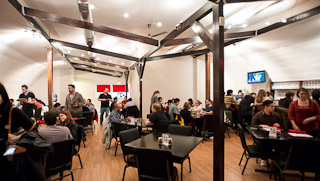 When Michi Ramen opened, they served both lunch and dinner for 7 days a week. They soon removed Mondays to provide some additional time for prep and to allow them time to make adjustments and changes as they saw the demand and feedback come pouring in. This last week, they removed (temporarily, I'm told) lunch service to focus primarily on dinner service because the previous weekend they had run out of food by 7:30pm. Turning away customers is never a good thing, but having a ramen so good that they run out of food has to be proof they're doing something right. Focusing on dinner service only will give them a chance to figure out how to meet the demand without any unhappy customers. Their plan is to bring back lunch service in the future and eventually return to 7-days a week.
When Michi Ramen opened, they served both lunch and dinner for 7 days a week. They soon removed Mondays to provide some additional time for prep and to allow them time to make adjustments and changes as they saw the demand and feedback come pouring in. This last week, they removed (temporarily, I'm told) lunch service to focus primarily on dinner service because the previous weekend they had run out of food by 7:30pm. Turning away customers is never a good thing, but having a ramen so good that they run out of food has to be proof they're doing something right. Focusing on dinner service only will give them a chance to figure out how to meet the demand without any unhappy customers. Their plan is to bring back lunch service in the future and eventually return to 7-days a week.Both Ramen Tatsu-ya and Michi Ramen are wonderful examples of ramen and definitely worth a visit from those interested in tasting real ramen for the first time as well as those, like me, who are addicted to ramen and need to satisfy their cravings. They each have their strengths and execute those strengths at a world class level (Ramen Tatsu-ya's chashu and Michi Ramen's tonkotsu broth) and both worthy of patronage.
Rumor is that this spring the team over at Komé is opening their own ramen-ya called Daruma Ramen in downtown on East 6th Street. Hopefully, with a dedicated kitchen focused on making ramen, they'll be able to elevate their dish to a similar level as Michi Ramen and Ramen Tatsu-ya. Then, in less than twelve months, Austin would have gone from none to three noteworthy ramen houses - enough to rival any city in the United States.
Ramen Tatsu-ya
8557 Research Blvd #126
Austin, TX 78758
Michi Ramen
6519 North Lamar Boulevard
Austin, TX 78752
512-386-1908
Related Articles

Here are my ramen posts:
http://madbetty.com/?s=ramen
I love Paul Qui, so it pains me greatly to say that the only time I've been to East Side King Hole in the Wall it was extremely underwhelming for me. My noodles were overcooked and super soft and mushy (no springiness whatsoever) and the broths just didn't work for me with too many dominating flavors (super salty, tasted like powdered spices, and in the tortilla soup overly strong lemongrass and keffir lime leaves) that weren't melding / blending. The eggs were phenomenal and the soft tofu served with the kimchee ramen was great. However, I honestly preferred the texture and flavor of the instant noodles they served at The Grackle and also preferred the broth there.
In either case, it's not really a fair comparison with the other ramen-ya in town since it's mostly just ramen in name. I'll visit again some time as it is possible that I hit them on a bad night.
I'm not sure you read the article... guessing you just read the title and then commented? I'm pretty sure I never say all the ramen in Austin is "good" and they aren't. There's only two worth eating at.